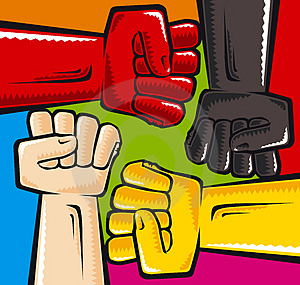Course:EDCP333/racism/Lesson Plan Ideas
Lesson Plan Ideas
From Rethinking Our Classrooms: Teaching for Equity and Justice, Volume 2 (2001)
Edited by Bill Bigelow, Brenda Harvey, Stan Karp, and Larry Miller
Williston, VT: A Rethinking Schools Publication
Rethinking the U.S. Constitutional Convention: A Role Play
(Bob Peterson, pp. 63-69)
Potential issues that could be addressed:
- Should slavery and slave trade be abolished, and should escaped slaves be returned to their owners?
- Who should be allowed to vote in our new nation, especially what role should gender, race, and property ownership play in such a decision?
Objectives:
- To learn about the social forces active during and immediately following the American Revolution
- To explore two burning questions that confronted the new American nation: slavery and suffrage
- To develop strong oral presentation skills, including both persuasive and argumentative skills
- To develop critical skills of examining arguments and social reality
Set the stage
- - To be introduced analyzing a poster/painting of that depicts the Constitutional Convention (why is it the white male that seem to be involved in the process, etc.)
- - Explain each group
- - Mini lecture on each of the group: white workers/indentured servants, enslaved African Americans, free African Americans, white women, male southern plantation owners, northern merchants and bankers, and native Americans/Iroquois nation
- - Divide the class into 7 groups (try to balance each group with strong readers, speakers, thinkers, and a racial and gender diversity)
- - Brainstorm in groups
- - Each group brainstorms their group’s position and ideas for argument/counter-argument/counter-counter-argument
Alliance building
- - Before the role play, students engage in an “alliance building” session in which they make arguments and try to win groups over to their positions
Prepare individual speeches
- - Each group member writes/prepares a speech about the key question(s) (e.g., should slavery be abolished?)
Practise speeches and final preparations
Role play
The Human Lives Behind the Labels: The Global Sweatshop, Nike, and the Race to the Bottom
(Bill Bigelow, pp. 91-99)
Bertolt Brecht’s poem: Questions from a Worker Who Reads
“I wanted students to see that every time they put on clothes or kick a soccer ball they are making a connection, if hidden, with people around the world” (Peterson, p. 95).
Seeing and understanding the people behind the products we use/enjoy in our daily lives gives students a chance to think about global capitalism and the “victims” of globalization – especially when these workers are around their age.
Using a soccer ball, students are first asked to describe the ball. Most students will describe the shape, its use, material, etc.
Introduce Bertolt Brecht’s poem and ask students to think about it for a minute
Then have them re-describe the soccer ball and see if anything changes – why?
Child Labour/Global Sweatshop: Making a Difference Project (taken from p. 98)
The project you choose is up to you. The major requirement is that you take your learning – about Nike; the “global sweatshop;” child labour; conditions for workers in Indonesia, China, Vietnam, Haiti, etc. – outside the walls of the classroom and into the real world.
Some examples:
- Write a detailed letter of opinion or inquiry to someone connected with these issues – for example, Phil Knight, Michael Jordan, the president of the US, U.S. labour unions, the Disney Co., the governments of China, Vietnam, or Indonesia, etc. In this letter, you can either make a strong point and back it up with evidence from class and your own research, or you can raise important questions. However, if you choose to raise questions, you still need to indicate lots of information that you know about the issue.
- Write an article for the Franklin Post, [the school newspaper], The Oregonian, or some other journal or newsletter.
- Prepare testimony for the Portland School Board, or some other agency or office.
- Design a presentation for classes at Franklin or one of our feeder schools (Kellogg, Mt. Tabor, et al.) to teach others about these issues.
- Become involved with a group that is trying to make a difference around these issues. Write up your reasons for choosing this group and what you hope to accomplish.
- Produce a rap, audio tape, video, or visual display on these issues. (You would also need to accompany this with an essay explaining and defending your point of view.) Write a skit to perform or a story to share.
Math, Maps, and Misrepresentation
(Eric Gutstein, pp. 112-114)
Analyzing map projections
- What do they really show?
- 2-dimensional representations of the earth that we often take for granted
- Comparison of the Mercator projection (traditional map in U.S. schools) and the Peters projection
All maps are misleading because they are 2-dimensional projections of a sphere
- Mercator:
- - Developed during European expansion when colonial exploitation required that maps be used to navigate accurately
- - Suffers from serious visual distortion by altering the relative size of land masses
- - The scale changes as you move away from the equator (countries far from the equator appear much larger than they are)
- - Germany is near the centre of the map, which may have made sense from the perspective of European expansionism – since Germany is in the northern quadrant of the earth, the only way to make it the centre is to push the equator approximately 2/3rd of the way down the map – compresses the Southern Hemisphere and enlarges the Northern
- Peters:
- - Developed to fairly and accurately portray the earth
- - Distorts shapes somewhat, but unlike the Mercator, it accurately presents the relative size of land masses
- - Can connect this lesson to the issues of race and racism (e.g., what does this distorted representation tell us?)
